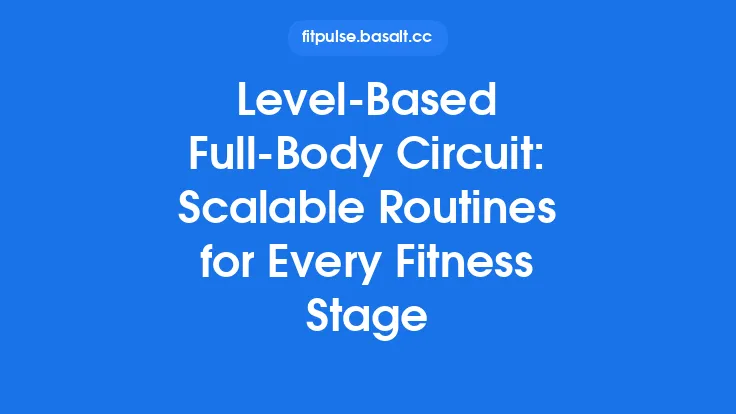Self‑myofascial release (SMR) is a hands‑on technique that lets you target the connective tissue surrounding your muscles—known as fascia—to improve mobility, reduce discomfort, and support overall performance. While the concept is simple—apply sustained pressure to a specific area and allow the tissue to “reset”—the practice can be surprisingly nuanced. This guide walks you through everything you need to know to start, progress, and maintain an effective SMR routine, no matter whether you’re a couch‑to‑5K beginner or a seasoned strength‑training veteran.
What Is Self‑Myofascial Release?
SMR is a self‑administered form of myofascial therapy. The “myo” refers to muscle, while “fascia” denotes the thin, web‑like connective tissue that envelops every muscle, bone, nerve, and organ. When fascia becomes tight, adherent, or dehydrated, it can limit range of motion, create uneven force distribution, and contribute to the sensation of “tightness.” By applying controlled pressure with a roller, ball, or other tool, you encourage the fascia to glide more freely over underlying structures, helping restore its natural elasticity.
Key points that set SMR apart from other recovery methods:
| SMR | Massage (therapist) | Foam Rolling (as a subset) |
|---|---|---|
| Performed by the individual, anytime, anywhere | Performed by a trained professional | Uses a roller but can be done solo; SMR includes a broader toolbox (balls, sticks, handheld devices) |
| Emphasizes sustained, static pressure on trigger‑like spots | Often involves dynamic strokes, kneading, and varied pressures | May focus more on larger muscle groups; SMR can target both large and small, deep areas |
| Allows you to “listen” to your body and adjust pressure instantly | Therapist controls pressure and technique | SMR incorporates the same tools but adds a systematic approach to assessment and progression |
How Fascia Responds to Pressure
When you press into a fascial band, several physiological events occur:
- Mechanical Deformation – The tissue stretches and temporarily thins, which can break up microscopic adhesions.
- Fluid Redistribution – Pressure pushes interstitial fluid out of the compressed area; when the pressure is released, fresh fluid rushes back, delivering nutrients and removing metabolic waste.
- Neural Modulation – Mechanoreceptors in the fascia (e.g., Ruffini endings) send signals to the central nervous system, prompting a relaxation response that reduces muscle tone.
- Viscoelastic Reset – Fascia exhibits both elastic (instantaneous stretch) and viscous (time‑dependent flow) properties. Sustained pressure allows the viscous component to “flow,” leading to a longer‑lasting lengthening effect.
Understanding these mechanisms helps you appreciate why a slow, deliberate roll can feel more beneficial than a rapid, high‑intensity massage.
Assessing Your Myofascial Landscape
Before you dive into a routine, spend a few minutes mapping out where you might need attention. Simple self‑assessment techniques include:
- Palpation Scan – Run your fingertips or a small ball over major muscle groups (quadriceps, hamstrings, calves, glutes, upper back). Notice any “hard spots” that feel denser or more tender than surrounding tissue.
- Movement Check – Perform a basic mobility test, such as a deep squat or overhead reach. Limited range, pain, or compensatory movement patterns often point to fascial restrictions.
- Post‑Exercise Feedback – After a workout, note any areas that feel unusually tight or sore the next day. Those are prime candidates for SMR.
Documenting these observations (a quick note in a training log) will let you track progress and adjust your routine over time.
Choosing the Right Tool for the Job
SMR tools come in a variety of shapes, sizes, and materials. While you don’t need an exhaustive catalog, having a few versatile options in your toolbox can make the practice more effective.
| Tool | Ideal Use | Typical Size/Shape |
|---|---|---|
| Standard Foam Roller | Large muscle groups (quads, hamstrings, calves) | 12–36 in length, 4–6 in diameter |
| Textured/“Ribbed” Roller | Adding mild focal pressure without a separate ball | Same dimensions as standard, with raised ridges |
| Lacrosse or Massage Ball | Small, deep areas (glutes, piriformis, forearms) | 2–2.5 in diameter, solid rubber |
| Handheld “Trigger” Stick | Targeting precise points on the back, shoulders, or calves | 12–18 in length, tapered ends |
| Hybrid “Cork” Roller | Combining firmness with a slight give for sensitive joints | Similar size to foam, but denser core |
When selecting a tool, consider the following evergreen criteria:
- Surface Texture – Smooth surfaces are gentler; textured surfaces provide micro‑massaging action.
- Density – A firmer core offers deeper pressure; a softer core is better for beginners or those with low pain tolerance.
- Portability – If you travel often, a compact ball or stick may be more practical than a full‑size roller.
Core Technique Fundamentals
Regardless of the tool you use, the basic mechanics of SMR remain consistent. Master these fundamentals before adding complexity.
- Set Up a Stable Base – Place the tool on a flat surface (floor, mat, or sturdy bench). Ensure you have enough space to move without hitting obstacles.
- Control the Pressure – Begin with light contact; gradually increase weight by shifting more of your body onto the tool. Your body weight, not your arms, should generate the pressure.
- Slow, Controlled Motion – Roll at a speed of roughly 1–2 inches per second. Faster movements tend to stimulate the nervous system rather than promote fascial lengthening.
- Pause on Tender Spots – When you encounter a “trigger point,” hold the pressure for 30–60 seconds. Allow the tissue to soften before continuing.
- Breathe Deeply – Inhale through the nose, exhale through the mouth. Controlled breathing helps relax the surrounding musculature and enhances the neural reset.
- Maintain Alignment – Keep the target muscle in a neutral position. For example, when rolling the hamstrings, keep the hips neutral rather than hyper‑extending the lower back.
Designing a Routine for Different Fitness Levels
Beginner (New to SMR)
- Frequency: 2–3 sessions per week
- Duration per Muscle Group: 30–45 seconds total (e.g., three 15‑second passes)
- Tools: Soft foam roller or smooth ball
- Focus Areas: Major muscle groups that experience the most soreness (quads, calves, glutes, upper back)
- Progression Tip: After two weeks, increase hold time on tender spots from 30 seconds to 45 seconds.
Intermediate (Regular Trainer)
- Frequency: 3–4 sessions per week (including post‑workout and dedicated recovery days)
- Duration per Muscle Group: 60–90 seconds total (e.g., six 15‑second passes)
- Tools: Mix of textured roller and lacrosse ball
- Focus Areas: Add secondary muscles (hip flexors, adductors, forearms) and begin addressing asymmetries.
- Progression Tip: Introduce “dynamic stretch‑roll” combos—roll a muscle, then perform a short static stretch for 20 seconds, repeat 2–3 times.
Advanced (Athlete or High‑Volume Trainer)
- Frequency: 4–6 sessions per week (often integrated into warm‑up, cool‑down, and separate mobility blocks)
- Duration per Muscle Group: 2–3 minutes total (multiple passes, varied angles)
- Tools: Combination of firm roller, textured roller, and handheld stick
- Focus Areas: Deep, localized work on known problem spots (e.g., piriformis, forearm extensors) and pre‑emptive maintenance on joints under high load (shoulders, knees).
- Progression Tip: Use “progressive overload” by adding a weighted vest or increasing body weight on the roller for 10–15 seconds per set, ensuring you never sacrifice form for intensity.
Building a Balanced SMR Session
A well‑rounded session typically follows a simple flow:
- Warm‑Up Activation (Optional) – Light cardio (5 minutes) to increase blood flow.
- Global Roll (Large Muscles) – Spend 1–2 minutes on each major group (e.g., quads, calves, back).
- Targeted Work (Specific Spots) – Identify tender points, hold for 30–60 seconds each.
- Cross‑Plane Movements – Change the angle of the tool (e.g., roll the glutes from side‑lying to supine) to address fascial layers that run in different directions.
- Finish with Mobility Integration – Pair a brief stretch or joint‑specific movement after each roll to lock in the gained length.
Common Myths Debunked
| Myth | Reality |
|---|---|
| “If it hurts, it’s working.” | Discomfort is normal, but sharp or radiating pain signals that you’re over‑pressuring a sensitive structure. |
| “You need a fancy roller to see results.” | Consistency with a basic foam roller or ball yields comparable benefits; tool selection is secondary to technique. |
| “SMR replaces stretching.” | SMR and stretching are complementary; SMR prepares the tissue, while stretching solidifies the range of motion. |
| “You only need SMR after a hard workout.” | Regular, low‑intensity SMR can prevent restrictions from forming, reducing the need for intense post‑session work. |
| “More pressure equals faster results.” | Excessive pressure can trigger protective muscle guarding, limiting the therapeutic effect. Gradual progression is key. |
Safety Guidelines and Contraindications
While SMR is generally safe, certain conditions warrant caution:
- Acute Inflammation or Swelling – Avoid rolling inflamed joints or tissues (e.g., recent sprain, bursitis) until the acute phase subsides.
- Open Wounds or Skin Irritations – Do not apply pressure over cuts, rashes, or infections.
- Severe Osteoporosis or Fractures – High‑impact pressure can compromise fragile bone; consult a healthcare professional first.
- Varicose Veins – Direct pressure may exacerbate venous pooling; use gentle techniques or avoid the area.
- Pregnancy – Certain pelvic and abdominal regions should be approached with care; seek guidance from a prenatal specialist.
When in doubt, start with a light touch and monitor how your body responds. If you experience persistent pain, numbness, or tingling, discontinue the activity and seek professional advice.
Tracking Progress and Adjusting Your Protocol
Because SMR is highly individualized, a simple tracking system can help you gauge effectiveness:
- Baseline Mobility Scores – Record a squat depth, overhead reach, or hip flexion angle before starting.
- Weekly Check‑Ins – Re‑measure the same movements after each week of consistent SMR.
- Pain/Discomfort Log – Note any areas that feel tighter or sore, rating intensity on a 0‑10 scale.
- Tool & Pressure Notes – Jot down which tool you used and perceived pressure level (light, moderate, deep).
If you notice stagnation (e.g., mobility scores plateau for three weeks), consider:
- Adding a new tool (e.g., a ball for deeper work)
- Extending hold times on stubborn spots
- Incorporating cross‑plane rolls to address different fascial layers
- Reducing overall session frequency to allow tissue recovery
Frequently Asked Questions
Q: How long should a typical SMR session last?
A: For most people, 10–15 minutes is sufficient to address major muscle groups and a few targeted spots. Advanced athletes may spend up to 30 minutes, especially when focusing on multiple problem areas.
Q: Can I use SMR on the same day as strength training?
A: Absolutely. Many athletes perform a brief SMR warm‑up before lifting to improve tissue pliability, then a more thorough session afterward for recovery.
Q: Is it okay to roll over joints (e.g., knees, elbows)?
A: Avoid direct pressure on the joint line itself. Instead, roll the surrounding musculature (e.g., quadriceps for the knee, triceps for the elbow) to indirectly affect joint mobility.
Q: How does SMR differ from “myofascial release” performed by a therapist?
A: The therapist may use slower, more sustained holds and may incorporate manual stretching. SMR relies on your own body weight and the tool’s surface to generate pressure, offering greater convenience but requiring self‑awareness.
Q: Will SMR help with chronic lower‑back pain?
A: It can be a useful component of a broader program, especially when tightness in the thoracolumbar fascia, glutes, or hip flexors contributes to the discomfort. However, persistent pain should be evaluated by a medical professional.
Final Thoughts
Self‑myofascial release is a versatile, low‑cost, and highly adaptable technique that empowers you to take charge of your own tissue health. By understanding the underlying anatomy, mastering core techniques, and tailoring the volume and intensity to your fitness level, you can reap lasting improvements in mobility, comfort, and performance. Remember that consistency, mindful pressure, and regular reassessment are the pillars of an effective SMR practice. Start simple, listen to your body, and let the fascia gradually regain its natural glide—your muscles will thank you.



